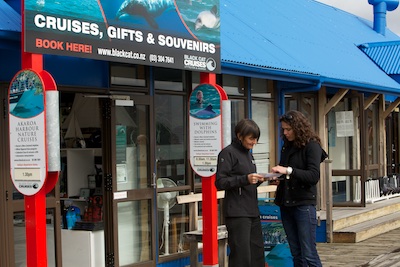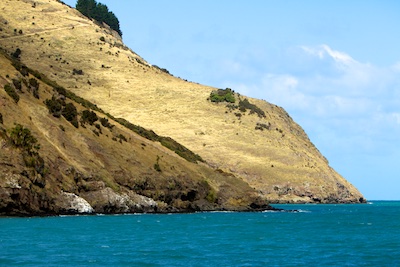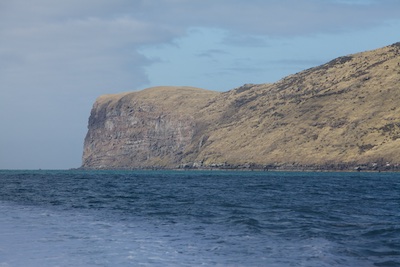Encounter with one the rarest dolphin species

Situated some 80 km from Christchurch, the Banks Peninsula stretches over 1,120 km². It was formed 9 million years ago following the eruption of an extinct ancient volcano whose crater has been submerged by the sea. This sheltered sound is home to the population of Hector’s dolphins and the port of Akaroa is where the first and last French colons settled down.

Magical interaction with Hector’s dolphins

There is suddenly some degree of excitement on the forward deck: a first fin, then a second one and a third, and finally eight dolphins show their rostrum! Hector’s dolphins can be easily identified by their round-shaped dorsal fins, which look like Mickey Mouse ears, a triangular black mask on the side of their faces and their beautiful coat with subtle spots. Hector’s dolphins are robust and compact in size. Their body length does not exceed 1m50. The boat is now surrounded by a shoal of a dozen dolphins which seem to take interest in our presence.

The skipper reduces the boat’s speed to a minimum and we wait for his signal before getting into the water. We have barely entered the water that the sea mammals start gliding among the swimmers before kicking underwater and resurfacing a few minutes later. We were all amused and astonished, it is hard to know which way to look and we try to spot them, sometimes through the troubled water, other times at the water surface, where the guide points us in the right direction. The moment is so intense that none of the swimmers complains of the cold water temperature – 13 °C. After hearing a blow right behind me, I only have time to put my head under the water when a dolphin brushes up against me and immediately moves away. Hector’s dolphins are a gregarious species and they can often be seen in groups of 8 to 20 individuals. These curious and playful creatures can be quite active with swimmers while keeping their distances. The less they move, the greater the chances for swimmers to see their new friends approaching. Those who try to follow them or to approach them will always be unsuccessful!

The usefulness of tourism in safeguarding dolphins

After a three-quarter-of-an-hour interaction with these lovely mammals, we get back on the boat with our hearts filled with joy and the memory card of our camera loaded with pictures. There is an abundance of comments and laughter across the boat; an energising euphoria now unites the swimmers, who are aware of the privilege they had to experience a unique encounter. Our guide is not at all surprised by this vibration of emotions and continues with the debriefing session. He seizes the opportunity to sensitise us about the vulnerability of this species. There are currently two known subspecies of this dolphin endemic to New Zealand. We have encountered Hector’s dolphins, which live off South Island in three genetically distinct populations, totalling some 7,270 individuals (Dawson et al. 2004; Gormley et al. 2005).

For their part, Maui’s dolphins live around North Island and the population of the species counts no more than 100 animals! It is actually one of the most threatened cetacean species in the world. Besides pollution, disturbance caused by humans, diseases and the degradation of habitats, incidental captures in gillnets are the biggest threat to these dolphins. Due to the continuous decline in population – 74% over 3 generations – the IUCN has listed the species as ‘critically endangered’. Hence the interest of monitoring the population and studying their long-term behaviour changes. ‘Does swimming with dolphins have a negative impact on the population?’ worryingly asks one of the passengers. According to our guide, as long as regulatory measures relating to approaching dolphins are complied with and the dolphins themselves continue to visit tourists, the impact remains very limited.

Exemplary collaboration between scientists and tourism operators
The Otago University professors, Liz Slooten and Steeve Dawson, are considered the sea mammal specialists in New Zealand. Drawing on her experience with dolphins and some 15-year collaboration with Black Cat Cruise, Liz Slooten has the legitimacy to say that tourism helps in safeguarding Hector’s dolphins in the Banks Peninsula.

She firmly believes that swimming with dolphins activities have a positive impact both for tourists and for the animals themselves. ‘You just have to look at the faces of people who see a dolphin for the first time, especially such a rare and remarkable species as the Hector’s dolphin, to realise that the experience can only move them and some of them will want to support the conservation actions in place for this species by donating money or by signing petitions, like the one that is circulating to request the government to extend the marine sanctuary. Even if it’s a small percentage of them, it is worth the effort.’
To date, tourism has not had a negative impact on the presence of dolphins in the bay. A few years ago, the keepers of the sanctuary expressed concern over the decline in temporary frequentation by dolphins and wondered if it was linked to tourism. Liz Slooten’s students reading for a Masters degree or a PhD have conducted a variety of complementary research studies in order to monitor the behaviour of dolphins and their frequentation of the bay over a number of years. No link has been confirmed with tourist excursions. ‘We provide feedback on our research to tourism operators as quickly as possible in order to avoid them having to wait for official publications and to allow direct use of the information, both at the level of biology and conservation of the species.’
For more than 20 years, between 1986 and 2006, researchers have conducted a variety of research studies on the morphology and distribution of Hector’s dolphin populations, including a photo-identification programme to estimate their survival and reproduction rates as well as their migration patterns. Acoustic data loggers are also used to know the amount of time spent by dolphins in the ports of North and South Islands while demographic analyses are undertaken on a regular basis to assess population trends.
Ultimately, the biologists manage to identify reliably 462 animals by their wounds, from the small marks on their dorsal fins to the large scars caused by shark attacks.
The survival rate of this dolphin species has improved by 5.4% since the setting up of the MPA
The team subsequently analysed the photographic observations using the catch-marking-remarking statistical approach and a classical population evaluation method in order to assess the impact of the Marine Protected Area (MPA) on Hector’s dolphins living in the surroundings. The results showed that the survival rate of this dolphin species has improved by 5.4% since the setting up of the MPA. This is a first in the field of marine ecology! According to Liz Slooten, ‘This study represents the first empirical evidence of the efficiency of MPAs in protecting endangered sea mammals.’ However, while the survival rate has improved significantly, the growth rate is unfortunately not high enough to prevent the continued reduction in population.
The importance of the size of MPAs
Certain fishing methods are banned or restricted within MPAs and the latter are often used to help prevent any accidental catch of sea mammals. To date, there was barely any empirical evidence of their efficiency, hence the importance of measuring their impact to justify their setting up. In addition to providing the first concrete evidence of the usefulness of MPAs, the study conducted by Liz Slooten’s team demonstrates the importance of long-term ecological monitoring. ‘The estimation of the evolution of the population of sea mammals often requires several years of research to produce data that is precise enough to identify the types of biological changes,’ says the marine biologist. ‘But the study also shows that the MPAs must be vast enough to be efficient.’ We know today that the efficiency of MPAs depends on their surface area.



